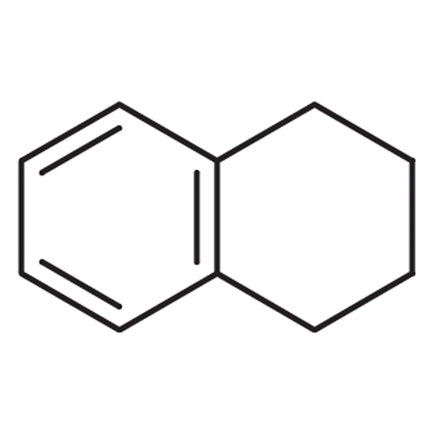Maximum quantity allowed is 999
Please select the quantity
CAS RN: 119-64-2 | Product Number: T0107
1,2,3,4-Tetrahydronaphthalene

Purity: >97.0%(GC)
Synonyms:
Product Documents:
| Size | Unit Price | Same Day | 2-3 Business Days |
|---|---|---|---|
| 25ML |
NT$720
|
15 | ≥80 |
| 500ML |
NT$960
|
≥40 | ≥100 |
* The above prices include freight cost, customs, and other charges to the destination except for products that need to be shipped by sea or dry ice. For details, please contact
our distributor
in Taiwan to order our product.
* The storage conditions are subject to change without notice.
| Product Number | T0107 |
| Purity / Analysis Method | >97.0%(GC) |
| Molecular Formula / Molecular Weight | C__1__0H__1__2 = 132.21 |
| Physical State (20 deg.C) | Liquid |
| Storage Temperature | Room Temperature (Recommended in a cool and dark place, <15°C) |
| Store Under Inert Gas | Store under inert gas |
| Condition to Avoid | Air Sensitive |
| CAS RN | 119-64-2 |
| Reaxys Registry Number | 1446407 |
| PubChem Substance ID | 87576117 |
| SDBS (AIST Spectral DB) | 907 |
| Merck Index (14) | 9221 |
| MDL Number | MFCD00001733 |
Specifications
| Appearance | Colorless to Almost colorless clear liquid |
| Purity(GC) | min. 97.0 % |
Properties (reference)
| Melting Point | -36 °C |
| Boiling Point | 207 °C |
| Flash point | 75 °C |
| Specific Gravity (20/20) | 0.97 |
| Refractive Index | 1.54 |
| Solubility in water | Insoluble |
| Degree of solubility in water | 47 mg/l 28 °C |
| Solubility (miscible with) | Benzene, Alcohol, Ether |
GHS
| Pictogram |



|
| Signal Word | Danger |
| Hazard Statements | H302 : Harmful if swallowed. H315 : Causes skin irritation. H319 : Causes serious eye irritation. H373 : May cause damage to organs through prolonged or repeated exposure. H336 : May cause drowsiness or dizziness. H304 : May be fatal if swallowed and enters airways. H411 : Toxic to aquatic life with long lasting effects. H227 : Combustible liquid. |
| Precautionary Statements | P501 : Dispose of contents/ container to an approved waste disposal plant. P273 : Avoid release to the environment. P260 : Do not breathe dust/ fume/ gas/ mist/ vapors/ spray. P270 : Do not eat, drink or smoke when using this product. P210 : Keep away from heat/sparks/open flames/hot surfaces. No smoking. P271 : Use only outdoors or in a well-ventilated area. P264 : Wash skin thoroughly after handling. P280 : Wear protective gloves/ eye protection/ face protection. P302 + P352 : IF ON SKIN: Wash with plenty of water. P370 + P378 : In case of fire: Use dry sand, dry chemical or alcohol-resistant foam to extinguish. P391 : Collect spillage. P331 : Do NOT induce vomiting. P314 : Get medical advice/ attention if you feel unwell. P337 + P313 : If eye irritation persists: Get medical advice/ attention. P305 + P351 + P338 : IF IN EYES: Rinse cautiously with water for several minutes. Remove contact lenses, if present and easy to do. Continue rinsing. P362 + P364 : Take off contaminated clothing and wash it before reuse. P332 + P313 : If skin irritation occurs: Get medical advice/ attention. P301 + P310 : IF SWALLOWED: Immediately call a POISON CENTER/doctor. P304 + P340 + P312 : IF INHALED: Remove person to fresh air and keep comfortable for breathing. Call a POISON CENTER/doctor if you feel unwell. P403 + P233 : Store in a well-ventilated place. Keep container tightly closed. P403 + P235 : Store in a well-ventilated place. Keep cool. P405 : Store locked up. |
Related Laws:
| RTECS# | QK3850000 |
Transport Information:
| UN Number | UN3082 |
| Class | 9 |
| Packing Group | III |
| H.S.code* | 2902.90-000 |
Application
Preparation of Anhydrous Hydrogen Bromide

Typical procedure: Bromine is slowly added dropwise to a round bottom flask containing a suspension of iron and 1,2,3,4-tetrahydronaphthalene. In the early stage of the reaction, the flask is cooled with water. The reaction is warmed to 30 to 40 ℃ allowing gas evolution. The gas is passed through a wash bottle containing 1,2,3,4-tetrahydronaphthalene in order to eliminate any bromine in the hydrogen bromide. For optimum yields of hydrogen bromide, dry the 1,2,3,4-tetrahydronaphthalene over anhydrous sodium sulfate and then distill it under a dry inert atmosphere (such as argon or nitrogen). If any moisture is introduced into the reaction, the yield of hydrogen bromide becomes remarkably poor.
References
- Inorg. Synth. 1939, 1, 149.
PubMed Literature
Articles/Brochures
Product Documents (Note: Some products will not have analytical charts available.)
Safety Data Sheet (SDS)
Please select Language.
The requested SDS is not available.
Please Contact Us for more information.
Specifications
C of A & Other Certificates
Please enter Lot Number
Incorrect Lot Number. Please input only the 4-5 alphanumeric characters before the hyphen.
Sample C of A
This is a sample C of A and may not represent a recently manufactured lot of the product.
A sample C of A for this product is not available at this time.
Analytical Charts
Please enter Lot Number
Incorrect Lot Number. Please input only the 4-5 alphanumeric characters before the hyphen.
The requested analytical chart is not available. Sorry for the inconvenience.




![1,2,3,4-Tetrahydronaphthalene [for Spectrophotometry] 1,2,3,4-Tetrahydronaphthalene [for Spectrophotometry]](/medias/T0713.jpg?context=bWFzdGVyfHJvb3R8MzM3NTl8aW1hZ2UvanBlZ3xhR0U1TDJobFppODRPVE15TXpZM09USTFNamM0TDFRd056RXpMbXB3Wnd8ZTlkM2E4ZWFhOTAwNzNjN2E0ZjQwNjFjYmE4MzZkNTI0NTNjZWE3ZDNmMTY4MDNlNGQxYWE2MjRhMWYyODE1Nw)